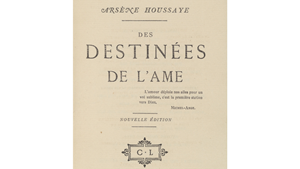
Harvard Library has removed human skin from the binding of a copy of Arsène Houssaye’s book Des destinées de l’âme (1880s), held at Houghton Library.
The volume’s first owner, French physician and bibliophile Dr. Ludovic Bouland (1839–1933), bound the book with skin he took without consent from the body of a deceased female patient in a hospital where he worked. The book has been in the collections of Harvard Library since 1934, initially placed on deposit by John B. Stetson, Jr. (1884–1952), an American diplomat, businessman, and Harvard alumnus (AB 1906), and later through donation by his widow Ruby F. Stetson to Houghton Library in 1954.
The removal of the human skin from Des destinées de l’âme follows a review by Houghton Library of the book’s stewardship, prompted by the recommendations of the Report of the Harvard University Steering Committee on Human Remains in University Museum Collections issued in fall 2022. After careful study, stakeholder engagement, and consideration, Harvard Library and the Harvard Museum Collections Returns Committee concluded that the human remains used in the book’s binding no longer belong in the Harvard Library collections, due to the ethically fraught nature of the book’s origins and subsequent history. The Library is now in the process of conducting additional provenance and biographical research into the book, Bouland, and the anonymous female patient, as well as consulting with appropriate authorities at the University and in France to determine a final respectful disposition of these human remains.
In the course of its review, the library noted several ways in which its stewardship practices failed to meet the level of ethical standards to which it subscribes. Until relatively recently, the library has made the book available to anyone who asked for it, regardless of their reason for wishing to consult it. Library lore suggests that decades ago, students employed to page collections in Houghton’s stacks were hazed by being asked to retrieve the book without being told it included human remains. In 2014, following the scientific analysis that confirmed the book to be bound in human skin, the library published posts on the Houghton blog that utilized a sensationalistic, morbid, and humorous tone that fueled similar international media coverage.
Harvard Library acknowledges past failures in its stewardship of the book that further objectified and compromised the dignity of the human being whose remains were used for its binding. "We apologize to those adversely affected by these actions".

ArtDependence Magazine is an international magazine covering all spheres of contemporary art, as well as modern and classical art.
ArtDependence features the latest art news, highlighting interviews with today’s most influential artists, galleries, curators, collectors, fair directors and individuals at the axis of the arts.
The magazine also covers series of articles and reviews on critical art events, new publications and other foremost happenings in the art world.
If you would like to submit events or editorial content to ArtDependence Magazine, please feel free to reach the magazine via the contact page.